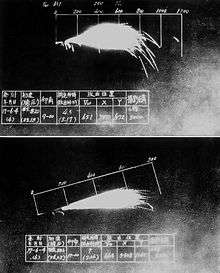San Shiki (anti-aircraft shell)
Sanshikidan (三式弾, "type 3 shell") was a form of ammunition: a World War II-era combined shrapnel and incendiary anti-aircraft round used by the Imperial Japanese Navy. The type of layered construction of the warheads were generically referred to as Beehive rounds. The shells were intended to put up a barrage of flame that any aircraft attempting to attack would have to navigate through. However, U.S. pilots considered these shells to be more of a pyrotechnics display than a competent anti-aircraft weapon.[A 1]


The Sanshiki anti-aircraft shell was designed for several gun calibers, including the 46 cm (18.1-inch) guns of the Yamato-class battleships.
Specifications
The 46 cm (18.1 in) Sanshiki Model 13 round weighed 1,360 kg (2,998 lb) and was filled with 900 incendiary tubes and 600 steel stays. The round was equipped with a delay fuze set before firing that detonated the shell at the set altitude; on explosion, the steel stays and the incendiary tubes were ejected in a 20-degree cone forward, with the shell fragments from the explosion itself further increasing the amount of debris. The incendiary tubes ignited about a half-second later and burned for five seconds with 5 m (16 ft) long flames.[1] Each of the incendiary tubes was a 90 mm long, 25 mm diameter hollow steel cylinder, filled with rubber thermite (phosphorus, vulcanized rubber, natural rubber, stearic acid, sulphur and barium nitrate) and ignited through holes on both sides. The rounds were similar to conventional shells, except for their wood-filled ogive and several layers of assembled fragments.
The 41 cm (16.1 in) round contained 1,200 incendiary tubes and on explosion burst into 2,527 fragments. By contrast a 46 cm round burst into 2,846 fragments. The 20.3 cm (8 in) round weighed 125.86 kg and contained 255 incendiary tubes and a 2 kg burst charge in its base. It used the 91 Shiki delay fuze. Its maximum altitude was 10,000 m. The burst charge scattered the fragments in a 12 degree cone. The maximum effective distance from the shell burst was about 1,000 meters, where the fragments reached dispersion diameter of 100 meters. A 12.7 cm (5 in) round contained 66 incendiary tubes and had a 10 degree dispersion angle with dispersion diameter of 54 meters.
Operational history
The Sanshiki anti-aircraft shells were used for shore bombardment during the Battle for Henderson Field. On 13 October 1942, in order to help protect the transit of an important supply convoy to Guadalcanal that consisted of six slower cargo ships, the Japanese Combined Fleet commander Isoroku Yamamoto sent a naval force from Truk—commanded by Vice-Admiral Takeo Kurita—to bombard Henderson Field. Kurita's force—consisting of the battleships Kongō and Haruna, escorted by one light cruiser and nine destroyers—approached Guadalcanal unopposed and opened fire on Henderson Field at 01:33 on 14 October. Over the next 83 minutes, they fired 973 14 in (360 mm) shells into the Lunga perimeter, most of them falling in and around the 2,200 m² area of the airfield. The bombardment heavily damaged the airfield's two runways, burned almost all of the available aviation fuel, destroyed 48 of the CAF's 90 aircraft, and killed 41 men, including six CAF aircrew.[2][3]
During the First Naval Battle of Guadalcanal on 13 November 1942, another Japanese naval force attempted to bombard Henderson Field but before they could reach their target they were intercepted by American cruisers and destroyers. The first few salvos from the battleships Hiei and Kirishima consisted of the Sanshiki anti-aircraft shells, as their crews were not expecting a ship-to-ship confrontation and took several minutes to switch to armor-piercing ammunition, with several Sanshiki shells hitting the cruiser USS San Francisco, causing less serious damage than what would have been inflicted by armor-piercing shells.
Even though the 3 Shiki tsûjôdan shells comprised 40% of the total main ammunition load of the Yamato-class battleships by 1944, they were rarely used in combat against enemy aircraft. The blast of the main guns turned out to disrupt the fire of the smaller antiaircraft guns. In addition the copper drive bands of the rounds were poorly machined and constant firing was damaging the gun rifling;[5][6] indeed, one of the shells may have exploded early and disabled one of Musashi's guns during the Battle of the Sibuyan Sea. Yamato fired these shells in two separate instances during Operation Ten-Go, first against PBM Mariner flying boats shadowing her, and later against the attacking aircraft of Task Force 58.
See also
During repairs after Operation Tungsten, the 38 cm SK C/34 naval guns of the Bismarck-class battleship Tirpitz were modified to allow their use against aircraft, being supplied with specially-fuzed 38 cm shells for barrage antiaircraft fire.[7]
Notes
- These shells may have been nicknamed "The Beehive" while in service. See: DiGiulian, Tony (23 April 2007). "Japanese 40 cm/45 (18.1") Type 94, 46 cm/45 (18.1") Type 94". Navweaps.com. Retrieved 23 March 2009.
References
- "Weapons". www.battleshipyamato.info.
- Morison, Struggle for Guadalcanal, Frank, Guadalcanal, pp. 315–20, 171–5, Hough, Pearl Harbor to Guadalcanal, pp. 326–27.
- "Oil and Japanese Strategy in the Solomons: A Postulate". www.combinedfleet.com.
- Thomas J. Cutler (14 October 2013). The Battle of Leyte Gulf: 23-26 October 1944. Naval Institute Press. pp. 146–. ISBN 978-1-55750-243-8.
- Steinberg, p. 54
- Garzke & Dulin, p. 267.